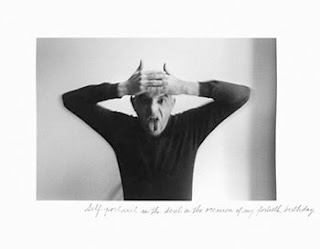Expanding on the idea presented in my last post, Autochromes, I’d like to dig deeper into the relationship between technology and art. My photography career began in a commercial photo lab in the pre digital days of toxic chemicals and long hours manipulating beams of light in darkened rooms.
The great advantage of having worked in this environment is that I got on the job training for all the technical possibilities different film stocks and chemical baths provided. One of the most interesting of the many Kodak films I encountered was Kodalith Ortho. This was an extremely high contrast black and white film that has wide exposure latitude. Not sold as a commercial film, it was designed for graphic arts applications. I soon discovered that I could take my original continuous tone black and white negatives and dupe them onto Kodalith stock creating a very contrasty effect where the mid-tones virtually disappeared.
At the same moment I was learning about Kodalith I became aware of a fashion photographer, Lillian Bassman, whose work closely echoed the effect of that film’s visual possibilities. Lillian established her reputation as a staff photographer for Harper’s Bazaar from 1949 through 1965. Under the tutelage of famed Art Director Alexey Brodovitch, her intimate, sensual black and white photographs stood toe to toe with the male fashion giants of the day – Richard Avedon, Irving Penn, Horst P. Host, and Cecil Beaton.
Employing a chiaroscuro effect her images of women balanced powerful lines and elegant composition. Her darkroom techniques included chemical bleaching and blurring to create an ethereal, watercolor like feel to her prints. Her images, while impeccably composed, were subtly different from her male counterparts of the day. Her subjects were often posed in profile or looking away from the camera, offering a more romantic, less overtly sexual countenance.
Lillian Bassman lived an unconventional life. She was born in Brooklyn, NY, in 1917 to bohemian Russian Jewish immigrants. During The Great Depression she modeled for artists at the Arts Students League as part of the WPA program and participated in many political strikes, once picketing in the nude to protest arts financing cuts. She attended school at the Textile High School in Manhattan and took evening classes at Pratt institute. In 1945 Lillian became Art Director for Junior Bazaar magazine where she established a working relationship with Richard Avedon, soon to become her friend and mentor.
In 1965 she abandoned her commercial fashion work to pursue personal projects. After many years away from the heated world of fashion editorial she was drawn back in when her downstairs neighbor, painter Helen Frankenthaler discovered garbage bags filled with Bassman's negatives in the backyard, abandoned for 20 years.
There is currently a tremendous renewal of interest in Lillian Bassman’s career. In 1996 she was hired by Neiman Marcus to shoot an advertising campaign. Now in her 90’s she still remains active, using Photoshop to fulfill her creative visions in a new age of digital reproduction. A book, Lillian Bassman Women has just been published and there is a concurrent exhibit at the Staley Wise Gallery in New York through Nov. 28th.
Her masterful darkroom techniques have enabled her to fulfill a rich photographic vision that still resonates today.























































